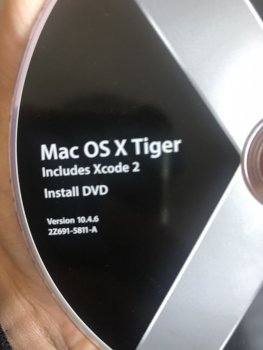Boot the iBook into Open Firmware( Command+OPT+O+F )
Code:
0 > devalias
pci0 /pci@f0000000
agp /pci@f0000000
pci1 /pci@f2000000
pci2 /pci@f4000000
uni-n /uni-n
ui2c /uni-n/i2c
ui2c-serial /uni-n/i2c/cereal
keyboard /pseudo-hid/keyboard
mouse /pseudo-hid/mouse
sound /pseudo-sound
eject-key /pseudo-hid/eject-key
nvram /nvram
enet /pci@f4000000/ethernet
fw /pci@f4000000/firewire
pci /pci@f2000000
usb0 /pci@f2000000/usb@1b,1
usb1 /pci@f2000000/usb@1b
usb-1a /pci@f2000000/@18
usb-1b /pci@f2000000/@19
usb-1c /pci@f2000000/@1a
usb-2a /pci@f2000000/@1b
usb-2b /pci@f2000000/@1b,1
usb-2c /pci@f2000000/@1b,2
mac-io /pci@f2000000/mac-io@17
mpic /pci@f2000000/mac-io@17/interrupt-controller
hd /pci@f4000000/ata-6@d/disk@0
cd /pci@f2000000/mac-io@17/ata-3@20000/disk@0
ide0 /pci@f2000000/mac-io@17/ata-3@20000/disk@0
ide1 /pci@f2000000/mac-io@17/ata-3@20000/disk@1
ultra0 /pci@f2000000/mac-io@17/ata-4@1f000/disk@0
ultra1 /pci@f2000000/mac-io@17/ata-4@1f000/disk@1
scca /pci@f2000000/mac-io@17/escc/ch-a
sccb /pci@f2000000/mac-io@17/escc/ch-b
ki2c /pci@f2000000/mac-io@17/i2c
ki2c-serial /pci@f2000000/mac-io@17/i2c/cereal
via-pmu /pci@f2000000/mac-io@17/via-pmu
rtc /pci@f2000000/mac-io@17/via-pmu/rtc
pi2c /pci@f2000000/mac-io@17/via-pmu/pmu-i2c
wireless /pci@f2000000/pci80211@12
adb /pci@f2000000/mac-io@17/via-pmu/adb
adb-keyboard /pci@f2000000/mac-io@17/via-pmu/adb/keyboard
adb-mouse /pci@f2000000/mac-io@17/via-pmu/adb/mouse
adb-eject-key /pci@f2000000/mac-io@17/via-pmu/adb/eject-key
usb2 /pci@f2000000/usb@1a
fan /uni-n/i2c/fan
veo0 /vsp@f9000000/veo@f9080000
veo1 /vsp@f9000000/veo@f9180000
first-boot /pci@f4000000/ata-6@d/disk
second-boot /pci@f2000000/mac-io@17/ata-3@20000/disk
last-boot /pci@f4000000/ethernet
screen /pci@f0000000/ATY,ViaParent@10/ATY,Via_A@0
ok
You can see I issued the devalias command to find the alias to the firewire bus:
Code:
fw /pci@f4000000/firewire
So "fw" is the short name for fw /pci@f4000000/firewire in the device-tree.
Now let's get a look at what devices are on the bus:
Code:
0 > dev fw ls
ff9dc3e8: /node@001451fffe42f4ba
ff9dc5e0: /sbp-2@4020
ff9dc828: /disk@0
ff9dcad0: /sbp-2@4000
ff9dcd18: /disk@0
ok
You can see I issued the command dev fw ls ( device firewire list ) what we see here is the children of the firewire bus, and as you can see I have two disks connected. I have one of my iBooks connected in Target Disk Mode, so one disk is the internal hard disk, and the other is the optical drive.
Now let's get a directory of the file system of one of the connected disks to see if it's the OS X install disk:
Code:
dir fw/node/@4000/@0:,\
sbp2:Open ->login?
speed=2 2 -
Size/ GMT File/Dir
bytes date time TYPE CRTR Name
82 1/14/ 6 10:37: 0 ._Install%20Mac%20OS%20X
12292 7/24/ 6 22:13:50 .DS_Store
7/24/ 6 22:13: 4 .Trashes
1/13/ 6 20:52:54 .vol
1/ 6/ 6 18:36:56 Apple%20Hardware%20Test%20Read%20Me.app
6/23/ 6 8:17:19 Applications
6/23/ 6 8:20:30 bin
1024 7/24/ 6 22:12:35 BTFL DMGR Desktop%20DB
3874 7/24/ 6 22:13:15 DTFL DMGR Desktop%20DF
1/13/ 6 11:52:31 dev
11 6/23/ 6 8:20:10 slnk rhap etc
0 7/24/ 6 22:13:15 fpka Install%20Bundled%20Software%20Only
6/14/ 6 6:50:43 Install%20Mac%20OS%20X%20and%20Bundled%20Software
12/21/ 5 3: 6:27 Japanese%20-%20%u65e5%u672c%u8a9e
6/23/ 6 8:20:13 Library
11 6/23/ 6 8:20:10 slnk rhap mach
8392100 6/ 7/ 6 23:23:43 mach_kernel
4/20/ 6 18:35:27 Optional%20Installs.mpkg
6/23/ 6 8:20:10 private
6/17/ 3 22:20: 7 Read%20Before%20You%20Install.app
6/23/ 6 8:20:28 sbin
6/23/ 6 8:17:17 System
11 6/23/ 6 8:20:10 slnk rhap tmp
6/23/ 6 8:17:41 usr
11 6/23/ 6 8:20:10 slnk rhap var
6/23/ 6 8:26:14 Volumes
1/14/ 6 10: 8:22 Welcome%20to%20Tiger.app
7/24/ 6 21:56:34 Xcode%20Tools
6/23/ 6 8:13:34 %00%00%00%00HFS+%20Private%20Data
ok
So I issued the command dir fw/node/@4000/@0:,\ ( note I use short names here to save typing the full name would have been fw /node@001451fffe42f4ba/sbp-2@4000/disk@0.
So we can use what comes before the @ or after it, depending on what is easier for use to type, or we could use the whole thing, but that would take way too long.........
As you can see from above the dir of the disk is in fact a Mac OS X Tiger install disk, so let's boot it:
Code:
boot fw/node/@4000/@0:,\\:tbxi
sbp2:Open ->login?
speed=2 2 load-size=298c4 adler32=24c61a36
parsing <CHRP-BOOT>
evaluating <BOOT-SCRIPT
The command I issued was:
Code:
boot fw/node/@4000/@0:,\\:tbxi
Everything else was the result of that in an Open Firmware telnet session.
If I wanted to boot from the other FW disk I would have issued:
Code:
boot fw/node/@4020/@0:,\\:tbxi
The :,\\:tbxi tells Open Firmware to search the disk recursively for a resource of the type :tbxi.
In this case it found that resource in /System/Library/CoreServices/BootX, as that is the default boot loader for OS X on PowerPC.
The file BootX has a file type in the resource fork of tbxi.


